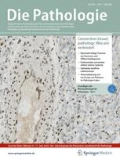Zusammenfassung
Die Obduktionszahlen sind weltweit rückläufig, obwohl die Obduktion als wichtiges Instrument des Qualitätsmanagements dient. In Zusammenarbeit mit der Abteilung für Herzchirurgie im Herzzentrum Leipzig wurden klinische und bei Obduktion gesicherte Diagnosen verglichen. Zwischen 2000 und 2003 wurden 468 Patienten obduziert. Daten der klinischen und postmortalen Untersuchung wurden prospektiv hinsichtlich der Todesursache, Begleiterkrankungen und postoperativen Komplikationen analysiert. Diskrepanzen zwischen den klinischen und den durch die Obduktion gesicherten Todesursachen wurden in 23,1% der Fälle nachgewiesen. Bei 99,1% der Patienten bestanden Begleiterkrankungen (z. B. Herzhypertrophie, Lungenembolie, Schlaganfall), 57,6% waren prämortal unbekannt, 19,2% hinsichtlich der chirurgischen Therapie relevant. Die Obduktion ist die letzte und umfassendste körperliche Untersuchung. Sie ist Grundlage der Ausbildung von Pathologen in der Interpretation zusammenhängender Diagnosen. Somit ist es Aufgabe der Pathologen, das Verständnis für die Obduktion unter den klinischen Kollegen durch enge Zusammenarbeit zu verstärken. Durch entsprechende Kommunikation kann die Obduktion ein effektives praxisrelevantes Ergebnis liefern.
Abstract
Autopsy rates have declined throughout the world although autopsy serves as an important tool in quality management. Working together with the Department of Heart Surgery of the Heart Centre in Leipzig clinical and autopsy diagnoses were compared. Between 2000 and 2003 an autopsy was performed in 468 patients. Data from clinical and postmortem examinations were prospectively analysed regarding causes of death, concomitant diseases and postoperative complications. Discrepancies between clinical and postmortem cause of death were identified in 23.1% of these patients. In 99.1% of the patients concomitant diseases (e.g. myocardial hypertrophy, pulmonary embolism, former stroke) could be identified, 57.6% were unknown pre-mortem and 19.2% were considered to be of relevance for surgical therapy. Autopsy is the final and most comprehensive physical examination. Autopsy is also the basis of training for pathologists in interpreting interrelated diagnoses. Therefore the task of pathologists is to enhance the appreciation of autopsy among clinical colleagues by working closely side by side. By communication an autopsy can deliver an effective achievement in terms of being relevant for praxis.

Literatur
Nestler K, Gradistanac T, Wittekind C (2008) Evaluation des klinischen Nutzens der Obduktionen. Pathologe 29:449–454
Rastan AJ, Gummert JF, Lachmann N et al. (2005) Significant value of autopsy for quality management in cardiac surgery. J Thorac Cardiovasc Surg 129:1292–1300
Interessenkonflikt
Der korrespondierende Autor gibt an, dass kein Interessenkonflikt besteht.
Author information
Authors and Affiliations
Corresponding author
Rights and permissions
About this article
Cite this article
Gradistanac, T., Wittekind, C. Obduktion als Instrument der Qualitätssicherung – Leipzig. Pathologe 32 (Suppl 2), 287 (2011). https://doi.org/10.1007/s00292-011-1466-7
Published:
DOI: https://doi.org/10.1007/s00292-011-1466-7

